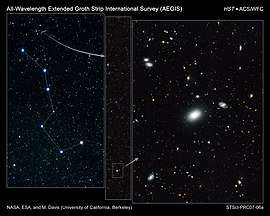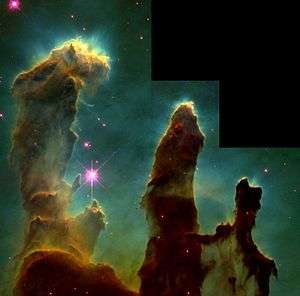Extended Groth Strip
The Extended Groth Strip[1] is an image of a small region between the constellations of Ursa Major and Boötes, based on the results of a series of observations by the Hubble Space Telescope. It covers an area 70 arcminutes across and 10 arcminutes wide, which correlates to a patch of sky roughly the width of a finger stretched at arm's length. The image was assembled from over 500 separate exposures taken with the Space Telescope's Advanced Camera for Surveys at 63 different pointings, spread out over the course of one year from June 2004 to March 2005. The complete image at the highest resolution in JPEG format is nearly 250 megabytes.

The Extended Groth Strip is named for Princeton University physicist Edward Groth. The project is jointly led by Sandra Faber, professor of physics and astronomy at the University of California at Santa Cruz, and Marc Davis, professor of astronomy at the University of California at Berkeley.
There are at least 50,000 galaxies in its view, giving new clues about the universe's youth, from its "preteen" years to young adulthood. The snowstorm of galaxies in the Hubble panorama does not appear evenly spread out. Some galaxies seem to be grouped together. Others are scattered through space. This uneven distribution of galaxies traces the concentration of dark matter, an invisible web-like structure stretching throughout space. Galaxies form in areas rich in dark matter.
The Extended Groth Strip is being studied in depth as part of the All-Wavelength Extended Groth Strip International Survey.


